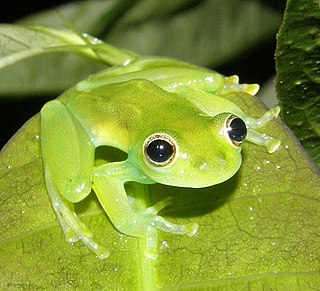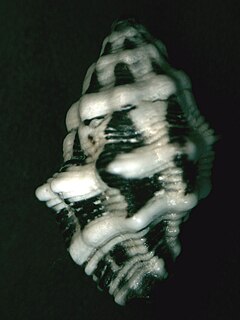
Junín National Reserve is a protected area located in the region of Junín, Peru. One of its main purposes is to protect the ecosystem and biodiversity of Lake Junín and the surrounding Central Andean wet puna.

Teratohyla spinosa is a species of frog in the family Centrolenidae. It is found in the Pacific lowlands of northern and central Ecuador and western Colombia, northward on the Pacific slopes Panama and Costa Rica, as well as on the Caribbean slopes of Costa Rica, Nicaragua, and Honduras.

Capparis is a flowering plant genus in the family Capparaceae which is included in the Brassicaceae in the unrevised APG II system. These plants are shrubs or lianas and are collectively known as caper shrubs or caperbushes. Capparis species occur over a wide range of habitat in the subtropical and tropical zones.

Bursaria spinosa is a small tree or shrub in the family Pittosporaceae. The species occurs mainly in the eastern and southern half of Australia and not in Western Australia and the Northern Territory. Reaching 10 m (35 ft) high, it bears fragrant white flowers at any time of year but particularly in summer. A common understorey shrub of eucalyptus woodland, it colonises disturbed areas and fallow farmland. It is an important food plant for several species of butterflies and moths, particularly those of the genus Paralucia, and native bees.

Morula is a genus of small, predatory sea snails, marine gastropod mollusks in the family Muricidae, the murex snails or rock snails.
Verrucaditha spinosa is a species of pseudoscorpion in the family Tridenchthoniidae.

Chaetophora elegans is the type species in the algae genus Chaetophora.

Byrrhidae, the pill beetles, is a family of beetles in the superfamily Byrrhoidea. These beetles are common in the forests of the Northern Hemisphere. They feed mainly on moss. Populations increase after wildfires. The oldest undoubted record of the family is Lidryops from the earliest Late Cretaceous Charentese amber of France, with other less certain records going back to the Middle Jurassic, but these possibly belong to Byrrhoidea.

Rivularia is a genus of cyanobacteria of the family Rivulariaceae.
Grevillea spinosa, also known as the spiny grevillea, is an evergreen shrub of the genus Grevillea native to an area in the east of the Mid West, northern Goldfields-Esperance and southern Pilbara regions of Western Australia.
Pterostylis chaetophora, commonly known as the Taree rustyhood, tall rusthood or ruddy hood is a plant in the orchid family Orchidaceae and is endemic to eastern Australia. It has a rosette of leaves at its base and up to twelve reddish-brown flowers with translucent "windows" and a fleshy, reddish-brown, bristly, insect-like labellum.
Notonecta spinosa is a species of backswimmer in the family Notonectidae. It is found in North America.
Hexatoma spinosa is a species of limoniid crane fly in the family Limoniidae.

Deinopis spinosa, known generally as the ogrefaced spider or net-casting spider, is a species of ogrefaced spider in the family Deinopidae. It is found in the United States, St. Vincent, and Venezuela. This spider is notable for its use of a net to catch prey. It does this by holding a small web stretched across its legs while it is suspended from a sparse web frame. When prey approaches the spider, it lunges forward and captures the insect in its net. In order to capture prey flying above it the spider uses a backward striking motion. When prey is outside its field of vision this spider appears to use a sensory organ located on its front legs to sense to prey. This sensory organ is known as the metatarsal organ. During the day, the spider is immobile and camouflages itself on its host palm plant. At night, the spider hunts.
Corythucha spinosa is a species of lace bug in the family Tingidae. It is found in the Caribbean, Central America, and North America.
Ischnomyia spinosa is a species of fly in the family Anthomyzidae.
Ischnomyia is a genus of flies in the family Anthomyzidae. There are at least two described species in Ischnomyia.

Thyanta pallidovirens, the red-shouldered stink bug, is a species of stink bug in the family Pentatomidae. It is found in Central America and North America.

Abacion is a genus of crested millipedes in the family Abacionidae. There are about 10 described species in Abacion.












